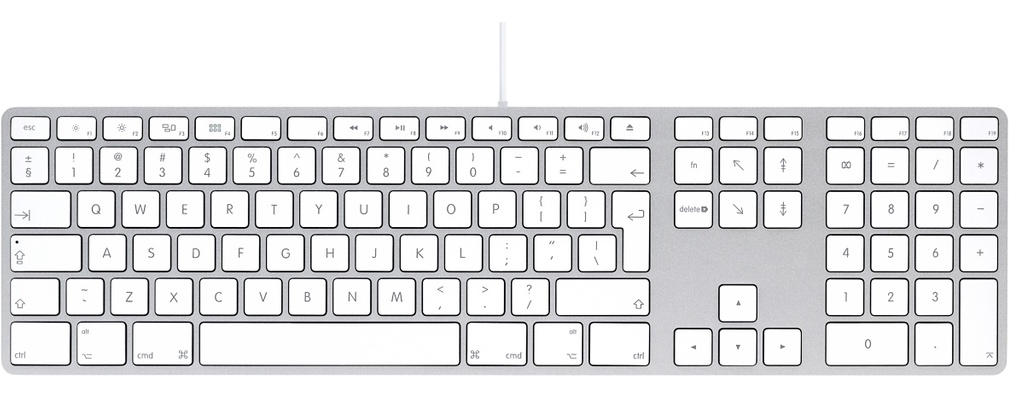Shortcut of NSMenuItem and NSButton
The shortcut key, or hotkey, is called Key Equivalent in Mac development. To use it, just press the corresponding key combination, and it will trigger a predefined application function.
Among NSControl’s subclass, NSMenuItem and NSButton support key equivalent, which can be implemented in a programmatic way or by changing the xib object property.
1. Composition of Key Equivalent
Normally, the key equivalent is a composite of two parts: some modifier keys and one basic key.
There are 4 possible modifier keys:
| Symbol | Name |
|---|---|
| ⌘ | Command |
| ⌃ | Control |
| ⇧ | Shift |
| ⌥ | Option, alias Alternate |
The normal key, includes alphabet, number, punctuation, symbol key, etc.
Key Equivalent may have no modifier key. This is very common in high-efficiency professional applications, for example, in Photoshop, moving layer’s shortcut key is V.
For symbol key, it refers to keys like ⎋ (escape), ↑ (up arrow). On Mac laptops, ⌦ (delete), ⇞ (page up), ⇟ (page down), ↖ (home), and ↘ (end) do not have dedicated physical keys. But there are substitutes to accomplish the same function:
| Key | Substitute |
|---|---|
| Delete | Fn + ⌫ |
| Page Up | Fn + ↑ |
| Page Down | Fn + ↓ |
| Home | Fn + ← |
| End | Fn + → |
2. Changing the xib object property
In Attributes panel of NSMenuItem/NSButton, Key Equivalent input field is used to set the shortcut. For example, a character, E, will be displayed capitalized.
If the shortcut includes ⇧ key, the input field will show an Alternates button, to let you choose displaying style between, like ⌘+ and ⇧⌘=.

3. Programmatic Way
3.1 Normal Key
The following code sets menuItem’s shortcut as E.
1
2
[menuItem setKeyEquivalentModifierMask:!NSEventModifierFlagCommand];
[menuItem setKeyEquivalent:@"e"];
The following code sets menuItem’s shortcut as ⌘E.
1
[menuItem setKeyEquivalent:@"e"];
The following code sets menuItem’s shortcut as ⇧⌘E.
1
[menuItem setKeyEquivalent:@"E"];
3.2 Symbol Key
First of all, you need to know the corresponding Unicode value.
| Symbol | Name | Unicode |
|---|---|---|
| ⌫ | Backspace | 0x0008 |
| ⇥ | Tab | 0x0009 |
| ↩ | Return | 0x000d |
| ⎋ | Escape | 0x001b |
| ← | Left | 0x001c |
| → | Right | 0x001d |
| ↑ | Up | 0x001e |
| ↓ | Down | 0x001f |
| ␣ | Space | 0x0020 |
| ⌦ | Delete | 0x007f |
| ↖ | Home | 0x2196 |
| ↘ | End | 0x2198 |
| ⇞ | Page Up | 0x21de |
| ⇟ | Page Down | 0x21df |
Note: NSBackspaceCharacter, NSTabCharacter, and NSCarriageReturnCharacter are defined in NSText.h, others are not. All of them (except 4 arrow keys) can be found here. Arrow keys do not use 0x2190, 0x2191, 0x2192, 0x2193, I don’t know the reason.
The following code sets menuItem’s shortcut as ⌘↩.
1
2
NSString *s = [NSString stringWithFormat:@"%c", NSCarriageReturnCharacter];
[menuItem setKeyEquivalent:s];
The following code sets menuItem’s shortcut as ⌘↑.
1
2
NSString *s = [NSString stringWithFormat:@"%C", 0x001e];
[menuItem setKeyEquivalent:s];
Attention: the format specifiers are different, the latter MUST use %C.
One more thing, the shortcuts displayed by menu items are different than the symbols on xib canvas and those printed on some keyboards.
| In xib | Running application |
|---|---|
 |
 |
Some keyboard models:
4. Dynamic Menu Items
Option key has an alias, Alternate key, it is called so when holding it, the menu item will appear in a different way.
In Apple’s Human Interface Guidelines, this menu item is called Dynamic Menu Items, and invisible by default.
For instance, click the MacOS desktop’s left top menu item, then hold the option key, and you will see, “About This Mac” changes to “System Information…” and its triggered action changes too.

In xib, to implement this:
- Add 2 NSMenuItem, they MUST be adjacent, with no other menu item between them.
- Set a valid shortcut for them, and the second’s shortcut MUST be the first’s shortcut, plus the
⌥key. - Check Alternate property for the second NSMenuItem.
Now, run the app and it will work as above menu item example.

Besides, in step 2, if you switch shortcuts of these two menu items, the default visible will be the second one instead, while they’re still alternate.

5. Some Design Guideline
- Do NOT add a shortcut for the contextual menu. Link
- Do NOT conflict with system shortcuts or other popular shortcuts, like
⇧⌘Q(log out account),⌘C(copy), etc. - Only add shortcuts for frequently used actions, to relieve the user’s learning and remembering burden. For example, about, is a rarely-used action, it does not need a shortcut.
- If the text on NSMenuItem and NSButton has the suffix “…”, it usually means that the corresponding action is important and needs to be reconfirmed by the user. So an alert panel normally pops up and asks the user if he wants to do so.
6. Other Weird Facts
⌃⇧1and⇧1can not exist together, or the former triggers the latter’s action.⌃⌥⇧1and⇧1can not exist together, or the former triggers the latter’s action.⌃⌥⇧1and⌃⇧1can not exist together, or the former triggers the latter’s action.⌃⇧A, its log info shows incorrectly for ⌃A, both in code and xib. What’s more, In code, ifkeyEquivalentis a capitalized alphabet andkeyEquivalentModifierMaskdoes not includeNSEventModifierFlagShift, the system will add⇧automatically in the shortcut UI.- In xib, set a menu item or button’s Key Equivalent with
⇧,⌘,=, and choose alternates as⌘+, then⌘=and⇧⌘=can both trigger its action. - When setting
keyEquivalentModifierMaskfor NSButton, it can not includeNSEventModifierFlagControl, or the shortcut will not work.
7. Reference
- Human Interface Guidelines
- Application Menu and Pop-up List Programming Topics
- https://stackoverflow.com/a/6230866/353927
- Unicode character table
8. Demo Project
Here is demo project.

